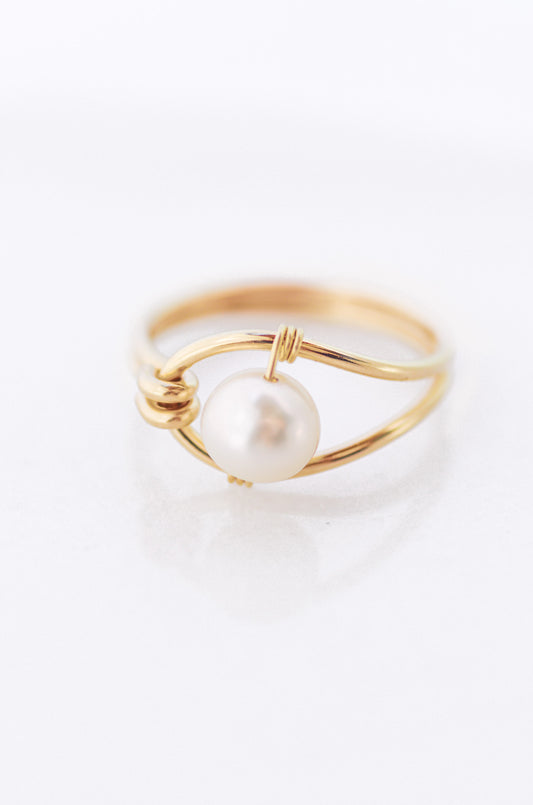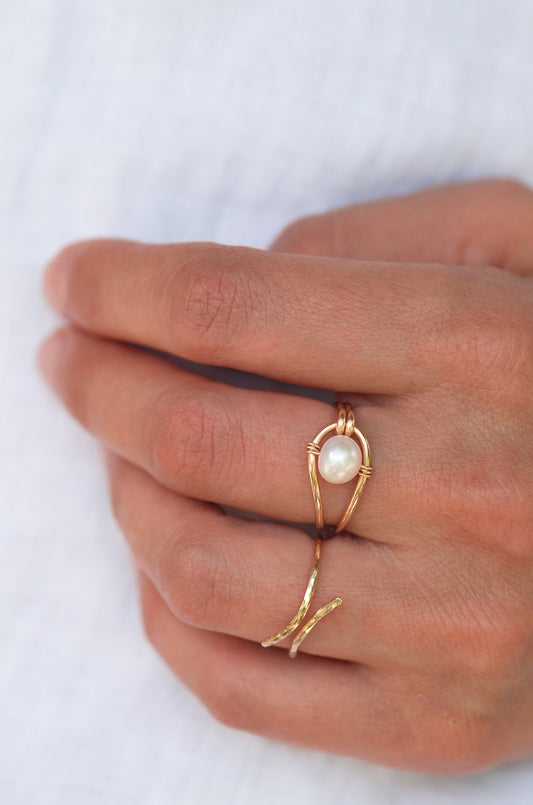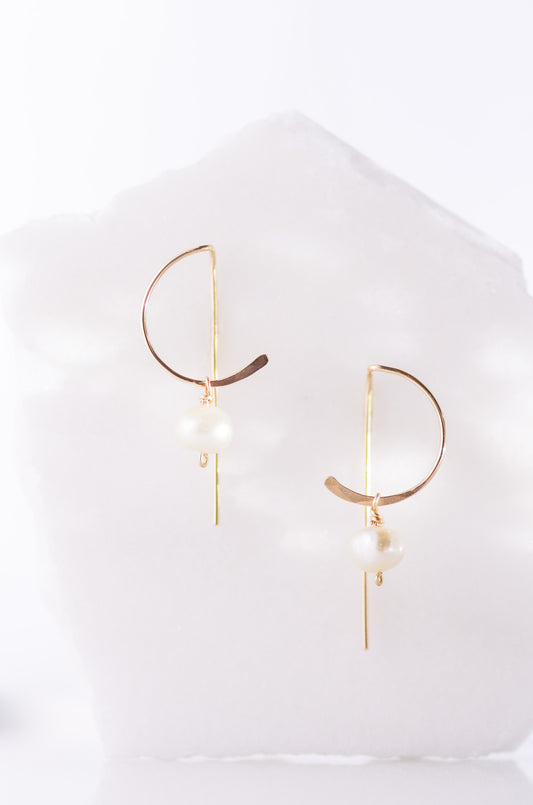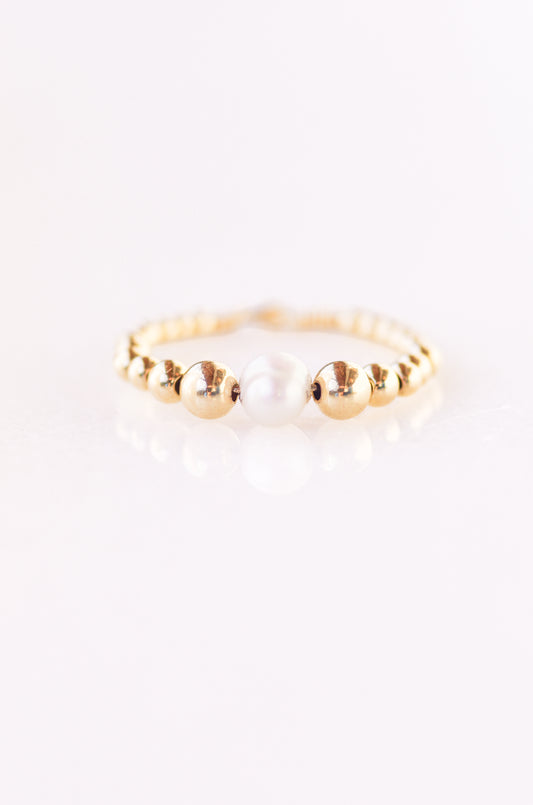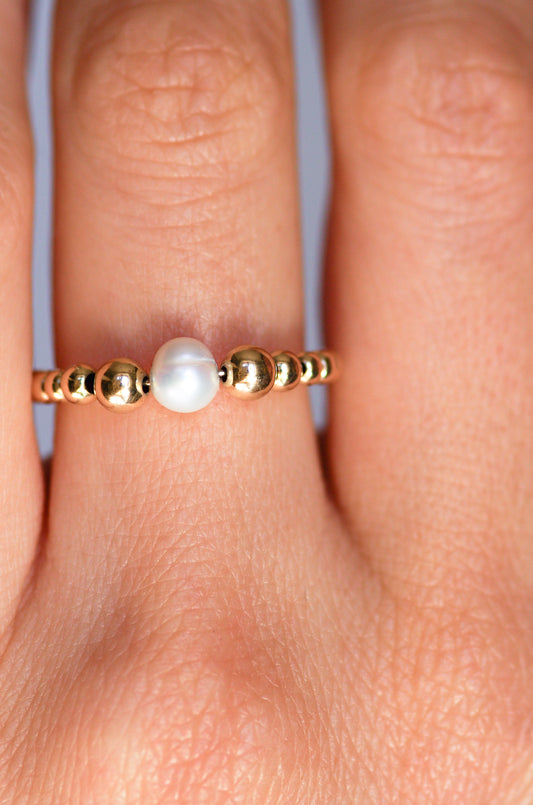
Why Repurposed Pearls Are Better
Share
Repurposed pearls are a smarter choice for jewellery enthusiasts who care about marine life, ethical practices, and reducing waste. Unlike new pearls, which harm ecosystems and raise ethical concerns, repurposed pearls reuse existing materials, offering a more eco-conscious option without sacrificing style. Here's why they stand out:
- Eco-Friendly: No new farming means no habitat destruction, water pollution, or plastic waste.
- Animal-Friendly: Avoids the invasive process of cultivating pearls, which harms oysters.
- Lower Carbon Footprint: Reusing pearls saves energy compared to producing new ones.
- Supports Artisans: Encourages skilled craftsmanship and local economies.
- Affordable and Unique: Vintage pearls often cost less and have distinct character.
Repurposed pearls combine elegance and responsibility, giving you jewellery with a meaningful story and a smaller environmental impact. It's a choice that aligns with mindful consumption and timeless style.
How Repurposed Pearls Help the Planet
Opting for repurposed pearls offers benefits that stretch far beyond the accessory itself. By breathing new life into vintage pearls, we sidestep the environmental toll of producing new ones. This approach reshapes luxury into something kinder to the planet. Let’s dive into how repurposing pearls supports ecosystems, cuts emissions, and minimizes waste.
Protecting Natural Ecosystems
When you choose vintage pearls, you’re helping to protect natural habitats and water systems. How? By reducing the demand for new pearl farming or extraction, we lessen the strain on delicate ecosystems. It's a simple yet impactful way to support the environment while embracing timeless style.
Lower Carbon Footprint
Creating new pearls isn’t just about beauty - it’s energy-intensive. From extracting raw materials to processing, traditional methods leave a hefty carbon footprint. For instance, producing just one mined carat of gold can emit a staggering 57 kg of carbon [5]. Repurposing vintage pearls, on the other hand, requires far less energy since the environmental impact was already absorbed during their original production. This approach aligns with the broader push to use recycled materials, cutting down on emissions and reducing the need for new resource extraction [4].
Less Waste
Repurposed pearls are a win for waste reduction. Many vintage pearls have already carried their environmental cost, and giving them a new purpose prevents them from ending up in landfills [3]. It’s a way to renew their value without adding to the planet’s burden.
The idea of a circular economy comes alive when repurposed pearls are paired with recycled metals and gemstones. Jewellery designer Zoë Chicco, known for her eco-conscious approach, highlights this beautifully:
I choose to use recycled gold not only because it's better for the environment but also because it's just as beautiful as newly mined gold. It's a sustainable choice we can all feel good about. [6]
Brands like AGMES and Laura Lombardi are also making waves by using recycled silver and platinum to create stunning pieces. These efforts not only reduce waste but also support local manufacturing [6]. By choosing vintage or second-hand jewellery, consumers play a pivotal role in cutting down the need for new material extraction [2], setting the stage for a greener jewellery industry.
Ethical and Social Benefits of Repurposed Pearls
Repurposed pearls come with a host of ethical and social advantages that resonate strongly with today’s mindful consumers. These vintage treasures not only reduce harm to marine ecosystems but also celebrate traditional craftsmanship and encourage thoughtful consumption.
A Choice for Ethical and Vegan Lifestyles
For individuals committed to vegan or cruelty-free living, repurposed pearls offer an attractive alternative. Traditional pearl farming raises serious concerns about animal welfare. As PETA points out:
Oysters and other molluscs only produce pearls as a response to a stressful environment, and it's speciesist to torment and kill an animal just because we think the end result is beautiful. [10]
The process of cultivating new pearls involves stress and harm to living creatures, making it incompatible with vegan principles [1][11]. Repurposed pearls, on the other hand, allow people to enjoy their beauty without contributing to the exploitation of oysters or other molluscs [10][11]. By choosing vintage pearls, you’re not only giving these gems a second life but also reducing the demand for new pearl harvesting. This approach particularly appeals to the 70% of millennials who prioritize sustainability when purchasing jewellery [9]. Beyond protecting marine life, the use of repurposed pearls also supports artisans and their communities.
Preserving Artisanship and Supporting Local Communities
Opting for repurposed pearls means championing the work of skilled artisans who breathe new life into vintage jewellery. This choice helps preserve traditional crafting techniques while providing economic benefits to local communities [8]. The ripple effect can be profound. For instance, when purchasing from social enterprises like Pearls With Purpose, over 64% of the proceeds go toward transforming lives [12]. As the organisation explains:
Each handcrafted product creates sustainable incomes/jobs and preserves cultural traditions. [12]
Real-world initiatives highlight these benefits. In 2011, the Artisan Fund enabled Ugandan bead-maker Sarah Akot to lead "paper to pearls" workshops in the Galápagos, sparking a decade of sustainable handcraft development [13]. Similarly, the Greenlandic Sheep Wool Project equipped the people of Qassiarsuk with tools to process wool, train artisans, and produce goods for locals and visitors alike [13].
At Rays & Riches, this dedication to local craftsmanship is central to our philosophy. By ensuring fair wages, safe working conditions, and ethical sourcing, we celebrate the artisanal skills that make each piece truly special.
Encouraging Thoughtful Consumer Choices
Repurposed pearls also promote mindful consumer habits, aligning with the values of the slow fashion movement [7]. This approach pushes back against the fast-fashion mindset in jewellery, emphasizing quality, meaning, and sustainability over fleeting trends.
Today’s consumers are increasingly seeking transparency from brands. As Emily from The South Sea Pearl Blog notes:
By choosing pieces crafted by local artisans, you help preserve traditional crafting techniques and provide valuable economic support to their communities. [8]
Buyers are also drawn to Statements of Provenance, which trace the journey of pearls from farm to showroom [7]. They prefer brands that prioritize low-impact farming practices, use recycled metals, minimize plastic, and adopt waste-reduction measures [7]. As Lindblad Expeditions explains:
Purchasing these items allows you to connect more deeply with the people and places you're visiting whilst also making a difference in an artisan's life. [13]
Repurposed pearls represent a thoughtful choice, blending luxury with responsibility. They let consumers indulge in beauty while supporting ethical practices, preserving traditional skills, and reducing environmental impact. It’s a way to honor craftsmanship and embrace a more responsible approach to jewellery.
Materials and Craftsmanship: The Rays & Riches Approach
At Rays & Riches, creating ethical jewellery with repurposed pearls is about more than just sourcing vintage elements. It’s a thoughtful process that combines top-tier materials, sustainable production methods, and a design philosophy deeply rooted in the traditions of Italian craftsmanship.
Gold-Fill Materials
Every piece starts with high-quality gold-fill materials, offering a clear edge over standard gold-plated options. Gold-fill contains 100 times more gold than gold-plated jewellery, making it more durable and valuable.
The gold-fill layer is bonded to a base metal using heat and pressure, a process that avoids wasteful chemicals and minimizes skin irritation. Instead of silver or traditional soldering methods, Rays & Riches uses ethically sourced, often recycled metals. This approach aligns perfectly with their dedication to giving new life to existing resources while reducing waste.
Repurposed Vintage Pearls and Gemstones
At the heart of Rays & Riches’ ethical ethos is their exclusive use of repurposed vintage pearls and gemstones. By choosing these materials, the brand avoids the environmental toll of fresh extraction.
Each vintage pearl carries its own story and character. Rather than being forgotten in old collections, these pearls are reimagined in modern designs, blending their rich history with a commitment to sustainability.
Using repurposed materials not only reduces strain on marine ecosystems and lowers the carbon footprint of traditional extraction but also ensures that every piece is genuinely one of a kind. No two pearls are alike, giving each customer a unique accessory that reflects both personal style and mindful consumer choices.
Italian-Inspired Design and Craftsmanship
Rays & Riches extends its sustainable material choices with a design philosophy inspired by Italy’s centuries-old jewellery-making traditions. Italian craftsmanship is celebrated for its attention to detail, use of premium materials, and timeless designs [14].
The brand’s designs emphasize balance, harmony, and natural patterns, drawing inspiration from organic shapes and the precision of the golden ratio. This approach celebrates the beauty of imperfection and reflects the Italian belief that the human touch adds life to every creation [15].
The collection offers a range of styles - from minimalist, delicate pieces to bold, playful designs - all unified by principles of elegance and natural beauty. Italian design naturally values quality, craftsmanship, and aesthetics, and Rays & Riches seamlessly integrates these values with modern sustainability goals [16].
sbb-itb-2024ddf
Repurposed Pearls vs. New Pearls: Side-by-Side Comparison
Deciding between repurposed pearls and newly harvested ones involves more than just aesthetics. Each choice reflects different values, especially when considering environmental and ethical factors. Understanding these differences can help you align your purchase with your personal priorities.
The jewellery industry is increasingly under scrutiny for its environmental and ethical impact. The table below breaks down the key differences between repurposed and new pearls, highlighting the ecological and ethical advantages of upcycled jewellery.
Comparison Table
| Factor | Repurposed Pearls | New Pearls |
|---|---|---|
| Environmental Impact | Minimal – no new extraction required | High – can damage marine ecosystems through dredging and over-farming [17] |
| Animal Welfare | Cruelty-free – no harm to animals | Requires the insertion of irritants into oysters [19] |
| Marine Ecosystem | Preserves existing ecosystems | Risks disruption and depletion of resources [18] |
| Chemical Usage | None during sourcing | Often involves bleaching and other treatments [18] |
| Carbon Footprint | Much lower | Higher due to farming and processing |
| Uniqueness | Each pearl has a distinct history | Uniform in appearance but less individual |
| Craftsmanship | Demands skilled upcycling techniques | Relies on standard pearl-setting methods |
| Cost Consideration | Typically more affordable | Generally more expensive [18] |
| Availability | Limited to vintage stock | Controlled by farming cycles |
One of the most striking ethical concerns involves animal welfare. According to PETA:
Oysters snap their shells tightly shut when they're disturbed by touch or even when they sense loud noises [19]
Natural pearls are incredibly rare, occurring in just one out of 10,000 wild oysters [19]. This scarcity has made cultured pearl farming the norm, despite its ethical and environmental drawbacks.
Repurposed pearls offer a thoughtful alternative. Jewellery designer Olga Shevchenko captures this sentiment beautifully:
As a jewelry designer, I am always excited when my clients bring me their grandma's pearls for re-designing. I feel like I am creating a link between the past and the present. As a family heirloom, the new "old" pearl necklace will stay in the family for a long time. And if the necklace looks modern, the next generations will be willing to wear it as well. [22]
Upcycling pearls involves intricate work, including disassembly, cleaning, and creative reassembly [20]. This process combines vintage charm with contemporary design, making each piece one-of-a-kind. The growing interest in repurposed jewellery is evident, with 540 people searching for "repurpose pearl necklace ideas" in a single day [21].
Choosing repurposed pearls not only supports sustainable practices but also celebrates craftsmanship and individuality. At Rays & Riches, we embrace this philosophy, drawing inspiration from Italian design traditions that emphasize quality, artistry, and the unique story behind every pearl. By opting for repurposed pearls, you’re making a choice that values beauty, ethics, and environmental care all in one.
Conclusion: Why Repurposed Pearls Are the Better Choice
Opting for repurposed pearls is more than just a fashion statement - it's a thoughtful choice rooted in ethical values and care for the planet. By embracing these pearls, we honor the craftsmanship of the past while actively reducing harm to the environment and marine life.
"By repurposing forgotten treasures, we not only avoid the environmental impact associated with pearl farming but also give them a second chance to be cherished once again." - Rays & Riches [23]
Repurposed pearls celebrate the original efforts of mussels and oysters, giving their natural creations a renewed purpose. Instead of leaving vintage jewellery to fade into obscurity, these pearls are reimagined into modern designs that blend timeless elegance with contemporary flair.
At Rays & Riches, this belief is at the heart of every piece. Using vintage pearls, gold-fill materials, and a chemical-free bonding process, each creation embodies the Italian principles of harmony, balance, and classic beauty.
Key Points to Remember
The advantages of repurposed pearls span across environmental, ethical, and economic considerations:
- Environmental Benefits: No new extraction or farming is required, which means a smaller carbon footprint and protection for marine ecosystems.
- Ethical Values: Repurposed pearls align with compassionate lifestyles, avoiding harm to living creatures while respecting the contributions of those from the past.
- Economic Value: These pearls not only provide better value but also support skilled artisans who specialize in upcycling. The process of disassembling, cleaning, and reimagining vintage pieces results in jewellery that’s truly one-of-a-kind.
Choosing repurposed pearls encourages transparency and accountability within the jewellery industry. It also supports a broader movement toward sustainable consumer habits, paving the way for a future where beauty and ethics go hand in hand.
Repurposed pearls stand at the crossroads of elegance, ethics, and sustainability. They show us that being mindful in our choices doesn’t mean sacrificing style - in fact, it leads to jewellery that’s more meaningful, distinctive, and reflective of both personal values and individual taste.
FAQs
Why are repurposed pearls a more sustainable choice than newly harvested ones?
Repurposed pearls offer a thoughtful way to breathe new life into existing gems, sidestepping the need for fresh harvesting. The process of harvesting new pearls can demand a lot of energy, consume resources, and cause disruptions to natural ecosystems. Opting for vintage pearls helps cut down on waste, lowers carbon emissions, and respects the resources that have already been utilized.
This choice not only reduces environmental impact but also reflects a commitment to ethical practices in jewellery. It’s a step toward embracing sustainability and mindful living in the way we accessorize.
Why are repurposed pearls a sustainable and ethical choice, especially for those following a vegan or cruelty-free lifestyle?
Repurposed pearls offer a meaningful option for those who care about sustainability and ethical practices. By giving vintage pearls a new purpose, no additional mollusks are harmed, making them a fitting choice for anyone following a vegan or cruelty-free lifestyle. This approach respects the pearls' natural origins while ensuring the effort and life involved in their creation are not in vain.
On top of that, reusing pearls significantly lowers the environmental toll that comes with mining or harvesting fresh ones. It helps protect marine ecosystems while breathing new life into these classic gems. Opting for repurposed pearls is a stylish way to blend timeless elegance with a conscious commitment to ethical and sustainable values.
How do repurposed pearls support artisans and preserve traditional craftsmanship?
Repurposed pearls hold a special place in preserving traditional craftsmanship, offering local artisans a chance to keep their heritage alive. By working with reused pearls, these skilled artisans can continue applying techniques passed down through generations, ensuring that these rich traditions endure.
Opting for repurposed pearls is also a step toward more sustainable practices. It minimizes the environmental strain linked to harvesting fresh materials while boosting local economies - particularly in rural communities - by creating demand for handmade, ethically crafted jewellery. It's a meaningful way to honor both artistry and environmental responsibility.

